-
Paper Information
- Next Paper
- Previous Paper
- Paper Submission
-
Journal Information
- About This Journal
- Editorial Board
- Current Issue
- Archive
- Author Guidelines
- Contact Us
Archaeology
p-ISSN: 2332-838X e-ISSN: 2332-841X
2021; 9(1): 21-23
doi:10.5923/j.archaeology.20210901.04

Printing of the Emotions and Digital Compositions
Iliakopoulοu Vassiliki
Ministry of Education, Teacher of Secondary Education, 55 Thessalias Street, Ano Ilioupoli Athens, Greece
Correspondence to: Iliakopoulοu Vassiliki, Ministry of Education, Teacher of Secondary Education, 55 Thessalias Street, Ano Ilioupoli Athens, Greece.
| Email: |  |
Copyright © 2021 The Author(s). Published by Scientific & Academic Publishing.
This work is licensed under the Creative Commons Attribution International License (CC BY).
http://creativecommons.org/licenses/by/4.0/

In the present thematic research, at the first level, the Head of Hermes is chosen as the study object of special interest. The head of Hermes is part of the well-known work of ancient Greek sculptor, Praxiteles, and dates back to around 340 B.C. The statue, due to its harmony and beauty, is the ideal image of classical beauty in sculpture which resulted to become known throughout the world within a short time of its discovery. The artist (author) chose this specific creation, an exact copy of the original, because it belongs to her personal collection and because of both its ideal proportion (analogy) and its purity of the shapes. It has been photographed from different positions, so that the change of lighting environment and angle of view affect the way the viewer perceives it. The aim of photography is to convey both the theatricality-drama and the emotional charge that it causes to the viewer, thus rendering elements such as calmness, contemplation, oppression and arrogance. In the second level of this research work, digital compositions are created using some of the artist’s (author’s) paintings and photographs. The main goal of the research is to highlight the composition of photographic material in a work completely different from the original. The whole process of this exercise was implemented with many test preparations in order to success the final result. The main elements were: Museum – city-monument: Objects, routes with multiple narratives.
Keywords: Arrogance, Contemplation, Oppression, Calmness
Cite this paper: Iliakopoulοu Vassiliki, Printing of the Emotions and Digital Compositions, Archaeology, Vol. 9 No. 1, 2021, pp. 21-23. doi: 10.5923/j.archaeology.20210901.04.
Article Outline
1. Introduction
1.1. Choice of Object
- In the light of this particular presentation/study I chose to search, as an object of interest, the head of Hermes of Praxiteles, part of the artifact of the renowned sculptor of ancient times. This work of art dated back at about 340BC. The sculpture, due to the harmony of its beauty, is the ideal image of the classical beauty in sculpture. Thus, within a short period of time since its retrieval, it became famous globally. This specific accurate copy of the original artifact, which belongs to the writer’s personal collection, was chosen not only for its ideal analogy, but also for the clearness of its shapes which are comprehended in it. It has been photographed from different positions /angles/sides so that the change of the surrounding light and angle transform the way we in which it is conceived by the beholder.1. Because of the ideal design analogy of this sculpture, the said research aims at the detection of attribution of the charismas and defects which may prevail in every human personality. Thus, according to the lighting, the standing position of the beholder and the differentiation of the scale, certain aspects of Hermes’s personality, such as cogitation, calmness, oppression and arrogance, are revealed. So, both the position and the lighting have directing impact, which may fold out the feelings of the said model. Hermes sometimes gives the impression of a peaceful cogitator/philosopher making the beholder see that particular euphoria and calmness of a rational, sensible entity. Nevertheless, negative aspects of his character being depicted in his figure, such as arrogance and oppression leading to submission, are also present.2. The postures reveal: calmness, oppression, arrogance.
2. Table
3. Clarifications
- In the pictures with the head of Hermes which are photographed in different scale and different lighting, somebody can discern the characteristics of every said sense.The calmness (picture 1): It is highlighted with the vertical and the horizontal line, as well as the balance which includes it.The cogitation (picture 2): The dark side of the sculpture refers to the beholder to thought, due to the fact that the light comes from behind of the sculpture.The oppression (picture 3): The compression, the narrowness of space, the suffocation, the stress arouse the beholder’s emotional loneliness, while the Hermes’s sculpture is photographed from above.The arrogance (picture 4): The photo-shoot is now being taken onwards giving the beholder the impression of the excellence of the model as opposed to him/her. The lock-in, the uncommunicativeness and the isolation are all consequences of the excellence of the model.All the above pictures have been photographed digitally with a NIKON camera and with two or three light sources in different scale. Then, they have been processed with the Photoshop programme. Afterwards, due to the monumentality and the narrativeness of the said head in the Ancient Greek Art, several posters are added the subject of which is:
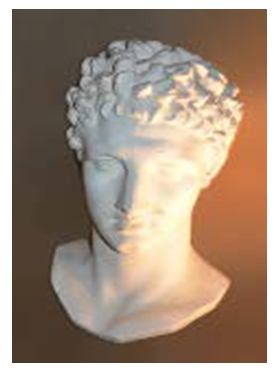 | Picture 1. The calmness |
 | Picture 2. The cogitation |
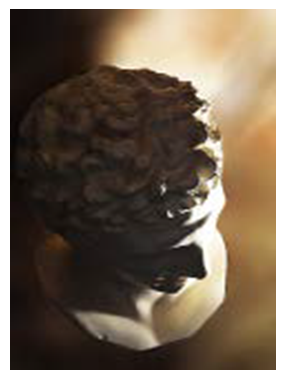 | Picture 3. The oppression |
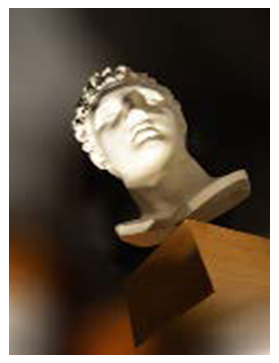 | Picture 4. The arrogance |
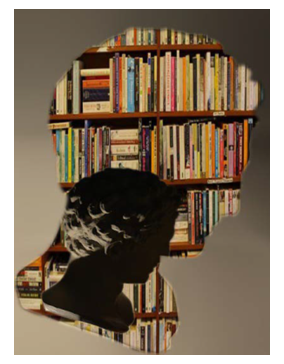 | Picture 5. “Remplacement” |
 | Picture 6. “Remplacement” |
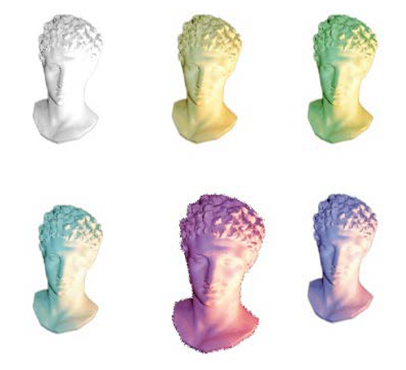 | Picture 7a. “Similarity |
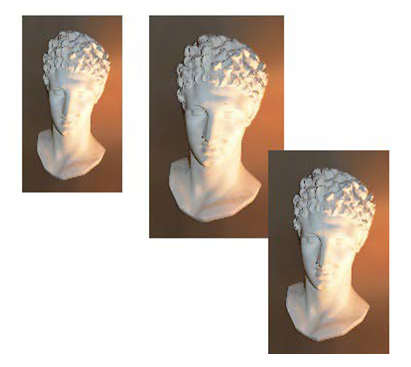 | Picture 7b. “Similarity |
4. Museum - City - Monument
- Objects, routs with multiple narrationsDigital Compositions(Photographic Collage)The digital compositions have been created with the writer’s paintings and photographs. The main target of the practice is the emergence of the composition of photographic material into a completely different work. The whole process of this practice created several probationary spadework, so that someone reach the final result. The main elements were: Museum-City-Monument: Objects, routs with multiple narrations. In the first digital composition (picture 8): Someone can observe a photographic depiction of Athens on the upper part of the work, while at the lower part a monument of the museum is depicted and a child accompanied by a familiar person (the writer in early childhood with her father) walking in the Agora past the monument (one of the writer’s paintings). At the bottom right part the exhibits of the Museum are distinctively highlighted. In this way not only are the Museum, the City and the Monument highlighted, but also the rest of the Museum’s exhibits.
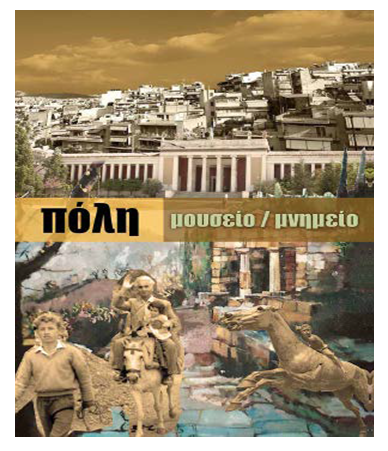 | Picture 8. “Caryatids and children picture” |
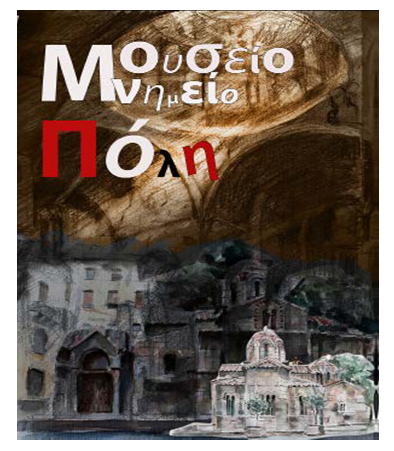 | Picture 9. “Panagia Kapnikarea of the 11th century” |
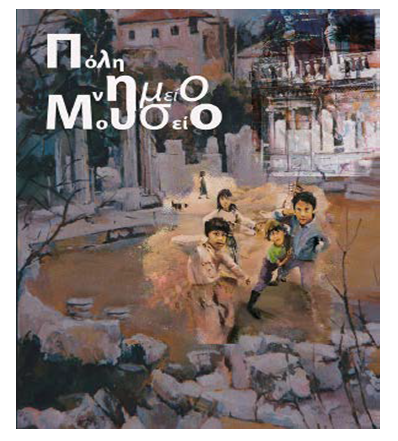 | Picture 10. “The author in early childhood with her father in the ancient Agora” |
 Abstract
Abstract Reference
Reference Full-Text PDF
Full-Text PDF Full-text HTML
Full-text HTML